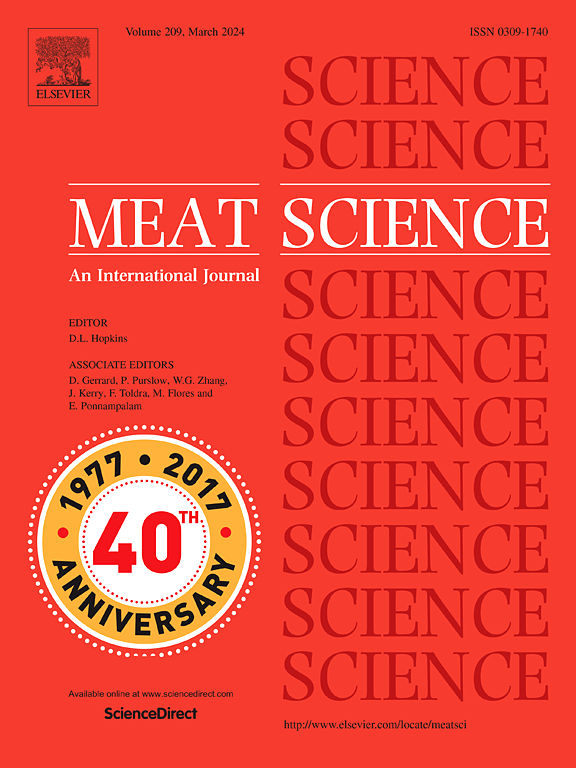消费者对风味的喜爱对澳大利亚羊肉的感官整体喜爱贡献最大
IF 6.1
1区 农林科学
Q1 Agricultural and Biological Sciences
引用次数: 0
摘要
未经训练的消费者对柔嫩、多汁、口味喜好和总体喜好的感官评分具有一定程度的依赖性,因为消费者区分这些特征的能力较差。考虑到总体喜欢度与所有特征都有很强的相关性,本研究评估了感官特征对澳大利亚羔羊总体喜欢度的贡献。未受过培训的澳大利亚消费者(n = 18720)根据澳大利亚肉类标准协议评估了一系列羊切肉的嫩度、多汁性、风味和喜欢度。对羔羊整体喜好最重要的贡献是风味(44.7%),其次是嫩度(28.3%)和多汁(27.0%)(P <;0.05;r2 = 0.88)。尽管多汁性的贡献变化很小,但感官性状对总体喜欢程度的贡献在肉质类别之间有所不同。随着腰肉肌内脂肪含量的增加,风味偏好对整体偏好的贡献变得更加重要。虽然烹饪方法之间的嫩度和多汁性的贡献存在微小差异,但未经培训的消费者无论切割类型如何,都以类似的方式评估总体喜好,这表明消费者具有一致评价肉制品的固有能力。本文章由计算机程序翻译,如有差异,请以英文原文为准。
Consumer flavour liking contributes the most to sensory overall liking of Australian lamb
Untrained consumer-determined sensory scores of tenderness, juiciness, flavour liking, and overall liking possess a level of dependency due to poorer consumer ability to discriminate between these traits. Given that overall liking is strongly correlated to all traits, this study evaluated the contributions of sensory traits to the overall liking scores of Australian lamb. Tenderness, juiciness, flavour liking and overall liking of a range of lamb cuts were assessed by untrained Australian consumers (n = 18,720) following Meat Standards Australia protocols. The most important contributor to lamb overall liking was flavour liking (44.7%), followed by tenderness (28.3%) and juiciness (27.0%) (P < 0.05; R2 = 0.88). The contribution of the sensory traits to overall liking varied between meat quality categories, although the contribution of juiciness varied minimally. The contribution of flavour liking to overall liking became more important as loin intramuscular fat content increased. Whilst small differences in the contribution of tenderness and juiciness were present between cooking methods, untrained consumers evaluated overall liking in a similar manner regardless of cut type, demonstrating consumers' inherent ability to consistently evaluate meat products.
求助全文
通过发布文献求助,成功后即可免费获取论文全文。
去求助
来源期刊

Meat Science
工程技术-食品科技
CiteScore
12.60
自引率
9.90%
发文量
282
审稿时长
60 days
期刊介绍:
The aim of Meat Science is to serve as a suitable platform for the dissemination of interdisciplinary and international knowledge on all factors influencing the properties of meat. While the journal primarily focuses on the flesh of mammals, contributions related to poultry will be considered if they enhance the overall understanding of the relationship between muscle nature and meat quality post mortem. Additionally, papers on large birds (e.g., emus, ostriches) as well as wild-captured mammals and crocodiles will be welcomed.
 求助内容:
求助内容: 应助结果提醒方式:
应助结果提醒方式:


